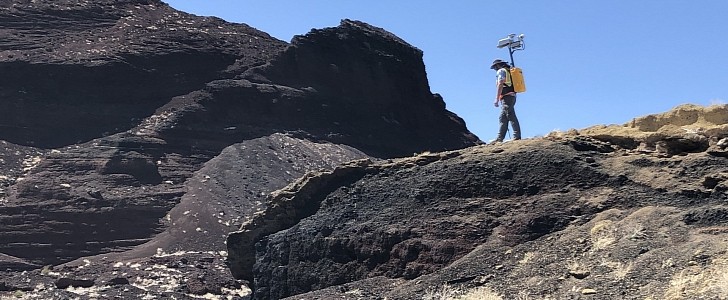GPS might be common down here on Earth where humanity has come to take it for granted. But on the Moon, astronauts have no such blessed technology to rely on, so they need something else to help them navigate its rocky surface. Enter the KNaCK, a “lunar backpack” that can guide explorers in their exploration of the most isolated and wild point on the Moon, the South Pole.
KNaCK stands for Kinematic Navigation and Cartography Knapsack and it is designed as a backpack, but a state-of-the-art one that works as a mobile LiDAR scanner. In friendlier terms, this lunar backpack technology creates a real-time, 3D map of the surrounding terrain. In techier terms, the KNaCK uses a “type of lidar called frequency modulated continuous wave (FMCW) in order to provide Doppler velocity and range for millions of measurement points per second”, to quote NASA. It is these points that create a high-resolution map of the terrain.
The KNaCK was developed by NASA and Torch Technologies Inc., with the project being initiated in 2020 when the two teamed up to create a backpack prototype that allows for accurate mapping without the use of GPS. Aeva Inc. is supplying the FMCW-lidar sensors for it.
This surveying tool creates the 3D maps at centimeter-level precision, keeping astronauts and their rover vehicles safe in the GPS-denied environment of the Moon. It shows them how far they’ve come and how long ‘til they reach their destination, as explained by Dr. Michael Zanetti, the leader of the KNaCK project.
While the backpack technology was designed for lunar exploration, specifically for the Artemis program, which aims to send us back to the Moon, it can also be used on other extraplanetary excursions.
But back to Artemis, the KNaCK will prove to be of significant help, as astronauts prepare to embark on the first mission to the Moon’s South Pole, where most of the terrain is in deep shadow, which makes it very difficult to explore. Not to mention that there won’t be time to fumble and stumble in the dark, because astronauts will have a limited oxygen supply in their suits. The LiDAR used in the lunar backpack also works in pitch blackness, which makes the explorers’ job considerably easier.
The prototype of the high-tech backpack weighs around 40 lb (18 kg) but the developing team is working on downsizing it as well as improving its electronics to cope with the effects of microgravity and solar radiation. They plan to run the next field test of the technology by the end of this month, at NASA’s Solar System Exploration Research Virtual Institute in New Mexico.
The KNaCK was developed by NASA and Torch Technologies Inc., with the project being initiated in 2020 when the two teamed up to create a backpack prototype that allows for accurate mapping without the use of GPS. Aeva Inc. is supplying the FMCW-lidar sensors for it.
This surveying tool creates the 3D maps at centimeter-level precision, keeping astronauts and their rover vehicles safe in the GPS-denied environment of the Moon. It shows them how far they’ve come and how long ‘til they reach their destination, as explained by Dr. Michael Zanetti, the leader of the KNaCK project.
While the backpack technology was designed for lunar exploration, specifically for the Artemis program, which aims to send us back to the Moon, it can also be used on other extraplanetary excursions.
But back to Artemis, the KNaCK will prove to be of significant help, as astronauts prepare to embark on the first mission to the Moon’s South Pole, where most of the terrain is in deep shadow, which makes it very difficult to explore. Not to mention that there won’t be time to fumble and stumble in the dark, because astronauts will have a limited oxygen supply in their suits. The LiDAR used in the lunar backpack also works in pitch blackness, which makes the explorers’ job considerably easier.
The prototype of the high-tech backpack weighs around 40 lb (18 kg) but the developing team is working on downsizing it as well as improving its electronics to cope with the effects of microgravity and solar radiation. They plan to run the next field test of the technology by the end of this month, at NASA’s Solar System Exploration Research Virtual Institute in New Mexico.






